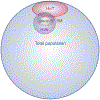Hymenoptera venom-induced anaphylaxis and hereditary alpha-tryptasemia
- PMID: 32769710
- PMCID: PMC8162786
- DOI: 10.1097/ACI.0000000000000678
Hymenoptera venom-induced anaphylaxis and hereditary alpha-tryptasemia
Abstract
Purpose of review: To discuss the association between the common dominantly inherited genetic trait hereditary alpha-tryptasemia (HαT) and hymenoptera venom-induced anaphylaxis (HVA).
Recent findings: Elevated BST has been correlated with more severe systemic anaphylaxis in humans in a number of settings - most notably in HVA. Clonal mast cell disease, in particular, systemic mastocytosis, is frequently associated with elevated BST, and is a major risk factor for severe HVA. However, clonal mast cell diseases are believed to be rare, whereas HVA is relatively more common. HαT affects an estimated 3-5% of Western populations and is the common cause for elevated BST in these individuals. An association between HαT and severe HVA, as well as clonal mast cell disease has recently been demonstrated wherein this trait modifies reaction severity in venom allergic individuals. A mechanism underlying this association has been proposed through the identification of naturally occurring heterotetrameric tryptases and characterization of their unique physical attributes.
Summary: Here we discuss the long-standing association between elevated BST and HVA severity, how HαT fits into this landscape, and review the clinical and mechanistic evidence that supports HαT as a modifier of HVA.
Conflict of interest statement
Conflicts of interest
The authors have no potential conflicts of interest to disclose.
Figures
Similar articles
-
Mast Cell Disorders and Hymenoptera Venom-Triggered Anaphylaxis: Evaluation and Management.J Allergy Clin Immunol Pract. 2025 Jan;13(1):40-48. doi: 10.1016/j.jaip.2024.08.034. Epub 2024 Aug 24. J Allergy Clin Immunol Pract. 2025. PMID: 39187156 Review.
-
Routine KIT p.D816V screening identifies clonal mast cell disease in patients with Hymenoptera allergy regularly missed using baseline tryptase levels alone.J Allergy Clin Immunol. 2021 Aug;148(2):621-626.e7. doi: 10.1016/j.jaci.2021.02.043. Epub 2021 Mar 19. J Allergy Clin Immunol. 2021. PMID: 33753098 Free PMC article.
-
High burden of clonal mast cell disorders and hereditary α-tryptasemia in patients who need Hymenoptera venom immunotherapy.Allergy. 2024 Sep;79(9):2458-2469. doi: 10.1111/all.16084. Epub 2024 Mar 13. Allergy. 2024. PMID: 38477502
-
Clonal mast cell disorders and hereditary α-tryptasemia as risk factors for anaphylaxis.Clin Exp Allergy. 2023 Apr;53(4):392-404. doi: 10.1111/cea.14264. Epub 2023 Jan 18. Clin Exp Allergy. 2023. PMID: 36654513 Review.
-
Heritable risk for severe anaphylaxis associated with increased α-tryptase-encoding germline copy number at TPSAB1.J Allergy Clin Immunol. 2021 Feb;147(2):622-632. doi: 10.1016/j.jaci.2020.06.035. Epub 2020 Jul 24. J Allergy Clin Immunol. 2021. PMID: 32717252
Cited by
-
Clinically accessible amplitude-based multiplex ddPCR assay for tryptase genotyping.Sci Rep. 2024 Jan 29;14(1):2416. doi: 10.1038/s41598-024-52983-8. Sci Rep. 2024. PMID: 38287122 Free PMC article.
-
Alpha-Tryptase as a Risk-Modifying Factor for Mast Cell-Mediated Reactions.Curr Allergy Asthma Rep. 2024 Apr;24(4):199-209. doi: 10.1007/s11882-024-01136-y. Epub 2024 Mar 9. Curr Allergy Asthma Rep. 2024. PMID: 38460022 Free PMC article. Review.
-
Hereditary Alpha-Tryptasemia Is Associated With Ongoing Symptoms in Individuals With Celiac Disease Despite Following a Gluten-free Diet.Am J Gastroenterol. 2025 May 14:10.14309/ajg.0000000000003537. doi: 10.14309/ajg.0000000000003537. Online ahead of print. Am J Gastroenterol. 2025. PMID: 40367491
-
Predictors of Clonality and Underlying Mastocytosis in Mast Cell Activation Syndromes.Curr Allergy Asthma Rep. 2024 Feb;24(2):25-32. doi: 10.1007/s11882-023-01122-w. Epub 2024 Jan 25. Curr Allergy Asthma Rep. 2024. PMID: 38270805 Review.
-
The Clinical Features of Hereditary Alpha-Tryptasemia—Implications for Interdisciplinary Practice.Dtsch Arztebl Int. 2024 Apr 19;121(8):258-264. doi: 10.3238/arztebl.m2023.0287. Dtsch Arztebl Int. 2024. PMID: 38260947 Free PMC article. Review.
References
-
- Guenova E, Volz T, Eichner M, Hoetzenecker W, Caroli U, Griesinger G, et al. Basal serum tryptase as risk assessment for severe Hymenoptera sting reactions in elderly. Allergy. 2010;65(7):919–23. - PubMed
-
- Rueff F, Przybilla B, Bilo MB, Muller U, Scheipl F, Aberer W, et al. Predictors of severe systemic anaphylactic reactions in patients with Hymenoptera venom allergy: importance of baseline serum tryptase-a study of the European Academy of Allergology and Clinical Immunology Interest Group on Insect Venom Hypersensitivity. J Allergy Clin Immunol. 2009;124(5):1047–54. - PubMed
-
- Castells MC, Hornick JL, Akin C. Anaphylaxis after hymenoptera sting: is it venom allergy, a clonal disorder, or both? J Allergy Clin Immunol Pract. 2015;3(3):350–5. - PubMed
-
- Khoury P, Lyons JJ. Mast cell activation in the context of elevated basal serum tryptase: genetics and presentations. Curr Allergy Asthma Rep. 2019;19(12):55. - PubMed
-
-
Lyons JJ, Chovanec J, O'Connell MP, Liu Y, Selb J, Zanotti R, et al. Heritable risk for severe anaphylaxis associated with increased α-tryptase-encoding germline copy number at TPSAB1. J Allergy Clin Immunol. 2020;In press.
Demonstrated for the first time HαT is associated with increased risk of severe HVA and clonal and non-clonal mast cell disorders, potentially resulting from unique activities of α/β-tryptase heterotetramers.
-
Publication types
MeSH terms
Substances
Grants and funding
LinkOut - more resources
Full Text Sources
Medical
Research Materials


